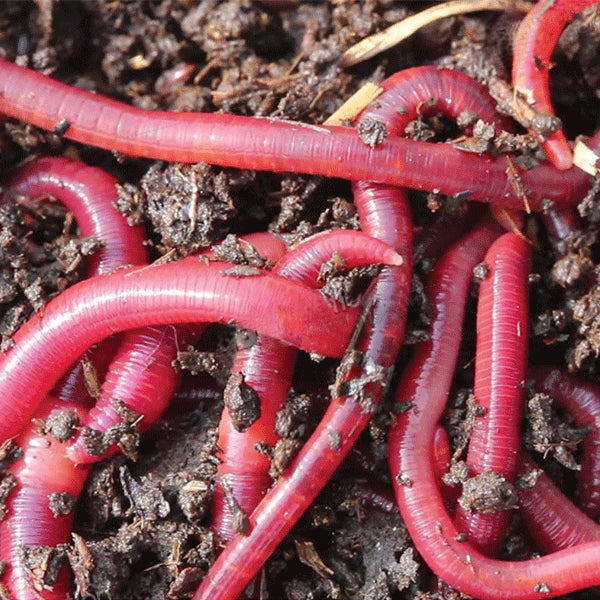Eco-friendly red wigglers: For organic gardening
Eco-friendly red wigglers: For organic gardening
Blog Article
Everything You Required to Learn About Red Wigglers for Composting
Red wigglers, or Eisenia fetida, play a critical duty in the world of composting, changing organic waste right into beneficial dirt modifications. Their unique organic qualities allow them to grow in numerous problems, making them a perfect choice for both beginner and skilled composters alike. Recognizing their needs and advantages is critical for developing a productive vermicomposting system. However, the process of establishing a worm bin and maintaining it can posture obstacles. To effectively harness the potential of these worms, one must discover the details of their treatment and administration.
What Are Red Wigglers?

(NC Worm Farms)
Indigenous to The United States and copyright, red wigglers are surface-dwelling microorganisms that like damp, warm habitats rich in decomposing natural issue. Their diet plan consists mainly of decaying plant material, food scraps, and various other natural debris, which they consume and break down successfully. As they absorb this material, they produce nutrient-rich castings that boost dirt fertility.
Red wigglers are hermaphroditic, possessing both male and female reproductive body organs, and can reproduce swiftly under optimal conditions. On the whole, red wigglers are vital contributors to the procedure of reusing organic waste right into useful compost.
Advantages of Making Use Of Red Wigglers
Utilizing red wigglers in composting systems uses countless advantages that improve both the performance of waste management and the quality of the resulting compost. These worms, medically called Eisenia fetida, are particularly efficient at damaging down raw material, turning kitchen area scraps and backyard waste right into nutrient-rich compost at an accelerated rate.
One of the key advantages of making use of red wigglers is their ability to take in big amounts of natural product, frequently processing their weight in food waste daily. This high usage price brings about faster decomposition and decreases the volume of waste sent to landfills. Additionally, the castings created by red wigglers are abundant in necessary nutrients, valuable microorganisms, and enzymes, making them an excellent plant food for gardens and plants.
In addition, red wigglers flourish in a variety of atmospheres, making them versatile for both interior and outdoor composting systems - red wigglers. Their existence in a compost container aids to aerate the product, avoiding odors and advertising a healthy and balanced composting procedure. On the whole, employing red wigglers not only contributes to effective waste management yet also supports lasting horticulture practices through the manufacturing of high-grade garden compost
(red wiggler compost bin)
Establishing Up Your Worm Container
To successfully set up a worm bin, it is vital to choose a suitable container that satisfies the demands of red wigglers while providing a conducive atmosphere for composting. An appropriate container can be made from plastic, timber, or steel, with an ability of at the very least 1 square foot for every pound of worms.
Guarantee the container has appropriate water drainage openings to stop excess moisture, as red wigglers thrive in a damp, but not waterlogged, environment. red wigglers. The bin ought to also be ventilated to offer adequate air flow, avoiding anaerobic conditions that could hurt the worms
A suitable location for the worm bin is an awesome, dark area, without direct sunlight and extreme temperature levels, as red wigglers favor a temperature level variety of 55 to 77 degrees Fahrenheit.
Prior to presenting the worms, prepare bed linen materials such as shredded newspaper, cardboard, or coconut coir, which will give both environment and food. Dampen the bed linen lightly to develop an inviting atmosphere for the worms. Think about putting a lid on the container to preserve humidity and lower bugs, while ensuring it can be conveniently eliminated for maintenance.
Feeding and Treatment Guidelines
Feeding red wigglers is an essential facet of preserving a healthy composting system. These worms thrive on a varied diet, largely composed of natural products such as vegetables and fruit scraps, important site coffee premises, and crushed eggshells. It is necessary to prevent feeding them meat, dairy, and oily foods, as these can develop unpleasant smells and attract pests.
When presenting food to your worm bin, cut or shred materials right into smaller items to facilitate quicker disintegration. Start with tiny amounts to assess the worms' consumption price, gradually boosting the amount as they adapt. It is suggested to alternating feeding areas within the bin to motivate thorough mixing and aeration of the garden compost.

Troubleshooting Common Issues
Keeping a growing worm composting system can occasionally offer obstacles that need interest and troubleshooting. Common issues consist of an undesirable odor, which frequently indicates overfeeding or the visibility of anaerobic problems. To correct this, decrease the quantity of food included and make sure appropriate aeration by blending the bed linen material.
Another constant issue is the escape of worms from the container. This can happen because of excessive dampness or inappropriate environmental problems. On a regular basis inspect the moisture degrees, aiming for a wet yet not soggy uniformity, and preserve optimal temperature levels in between 60-80 ° F(15-27 ° C )to create a comfy habitat for your red wigglers.
Parasites, such as fruit flies, can likewise invade worm containers. red wigglers. To fight this, cover food scraps with a layer of bedding or shredded paper to prevent flies from laying eggs. Additionally, make certain that any kind of food added is fresh and without mold, which can attract undesirable parasites
Lastly, if your worms appear non-active, inspect for stress aspects such as temperature changes or poor wetness. Addressing these typical concerns will assist maintain a healthy and effective worm composting system.
Conclusion
In summary, red wigglers, or Eisenia fetida, play an important function in lasting waste administration via vermicomposting. Correct arrangement and upkeep of a worm container, along with adherence to feeding standards, make certain a growing ecosystem that minimizes landfill contributions.
Report this page